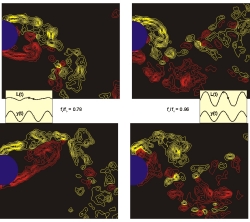You are here
Home ›Transition Between Modes of the Near-wake of an Oscillating Cylinder
Transition between modes of the near-wake of an oscillating cylinder. Transverse oscillations of a cylinder give rise to vorticity layers with small-scale vortical structures. Eventually these layers agglomerate into larger Kármán-like vortices. The timing of the large-scale vortex formation relative to the cylinder motion, as well as its formation length, are a strong function of the excitation frequency fe relative to the inherent Kármán frequency fo for the corresponding stationary cylinder. Abrupt changes in the process of vortex formation are attainable with small changes in fe/fo. The top row of images corresponds to the same phase of the cylinder displacement y(t). Likewise, the bottom row corresponds to a later phase on the y(t) trace. Transition between the mode shown in the images of the left column relative to the mode exhibited in the right column results in a dramatic increase of the fluctuating lift L(t), evident by comparing the traces in the insets. For the images in the top row, the initially-formed vortex is from the bottom of the cylinder in the left image (prior to transition), while it is from the top of the cylinder in the right image (after transition). In the bottom row of images, the formation length of the vortical structure from the bottom surface of the cylinder is substantially shortened after transition. In a larger field of view (not shown), the images in the left column correspond to eventual formation of counterrotating vortex pairs, while in the right column of images, the classical Kármán street is formed. Larger-view patterns correspond respectively to the 2P and 2S modes of Williamson and Roshko (1988). Reynolds number is Re = 2,290; amplitude A of the cylinder oscillation relative to diameter D is A/D = 0.5.

This investigation considers the wake states of a cylinder subjected to forced oscillations at frequencies close to the Kármán frequency. Two distinctly different wake states are observed. The emphasis is on the transition between these states, which is characterized in terms of the lift force on the cylinder and the instantaneous patterns of vortex structures in the near-wake. As the frequency of oscillation increases, there is simultaneously an abrupt jump in the lift force and a change in the mode of vortex shedding. The jump in the lift force involves a sharp increase in the magnitude of the lift coefficient and a phase shift of the order of 180°. The corresponding mode change involves an alteration in both the timing of the vortex initially shed form the cylinder and the overall pattern of vortices in the near-wake. Whilst previously these changes have been observed individually in separate forced vibration investigations, we show conclusive evidence that these two events are intrinsically linked. Moreover, for a narrow band of frequencies, a self-excited transition is possible, where the wake state changes while the cylinder oscillates at a constant frequency.
